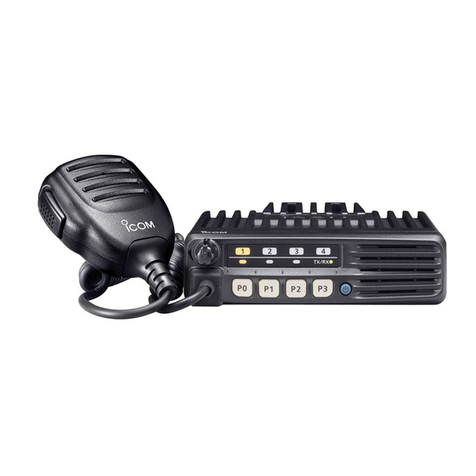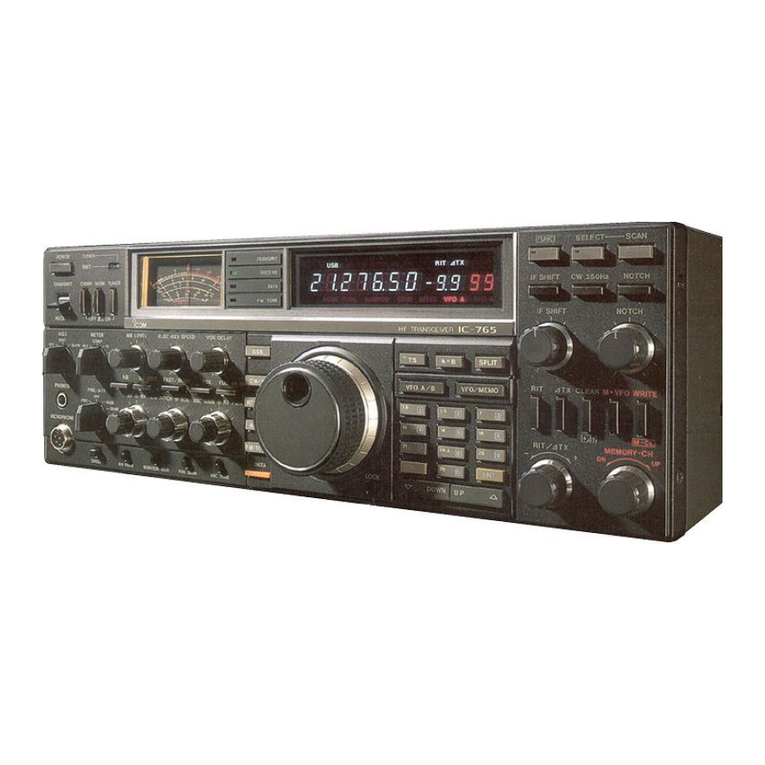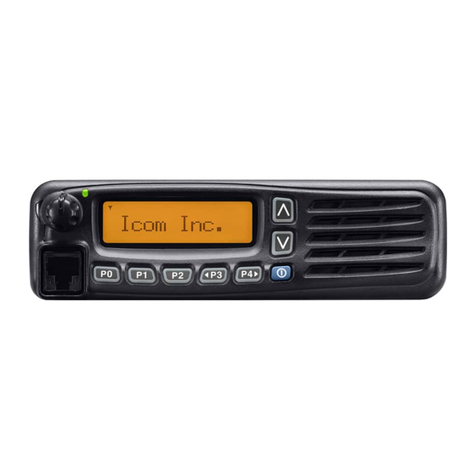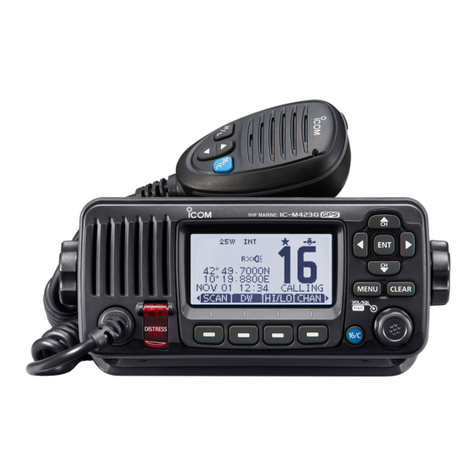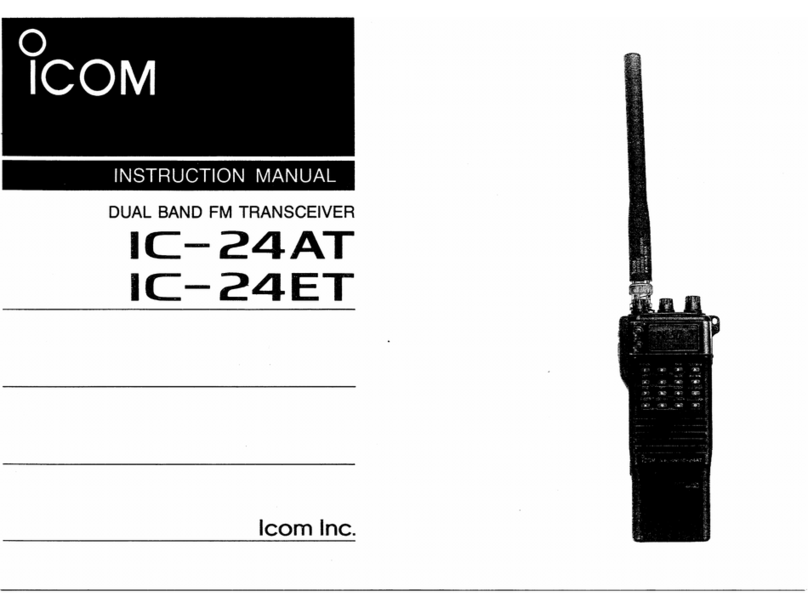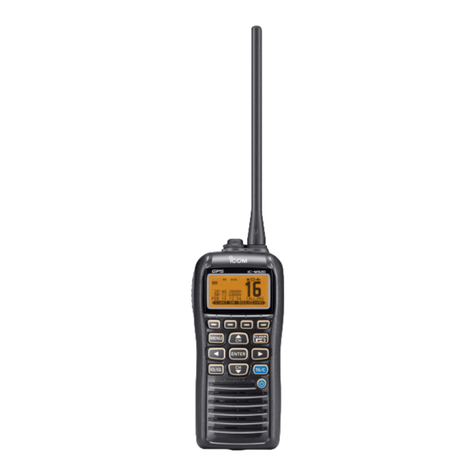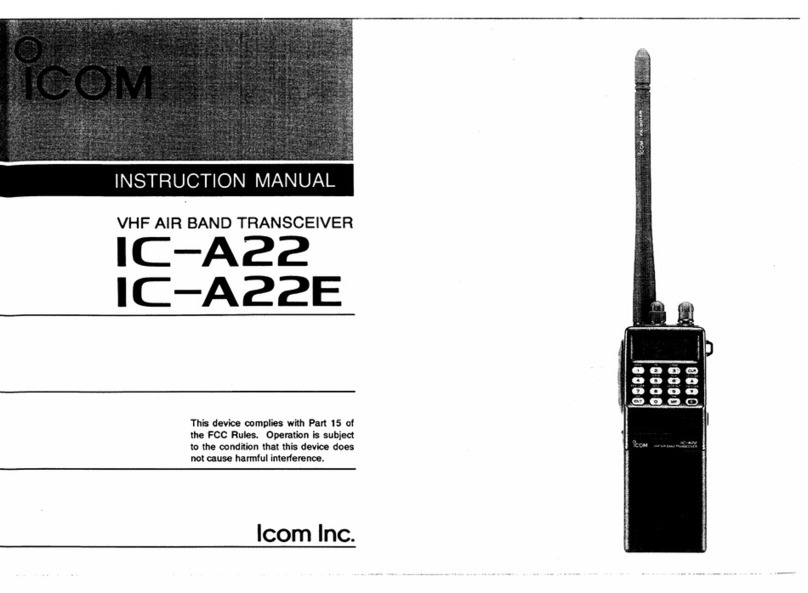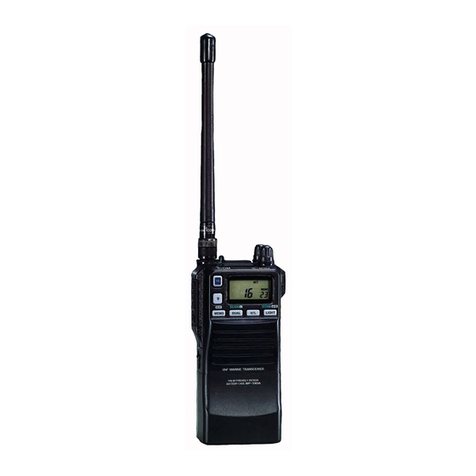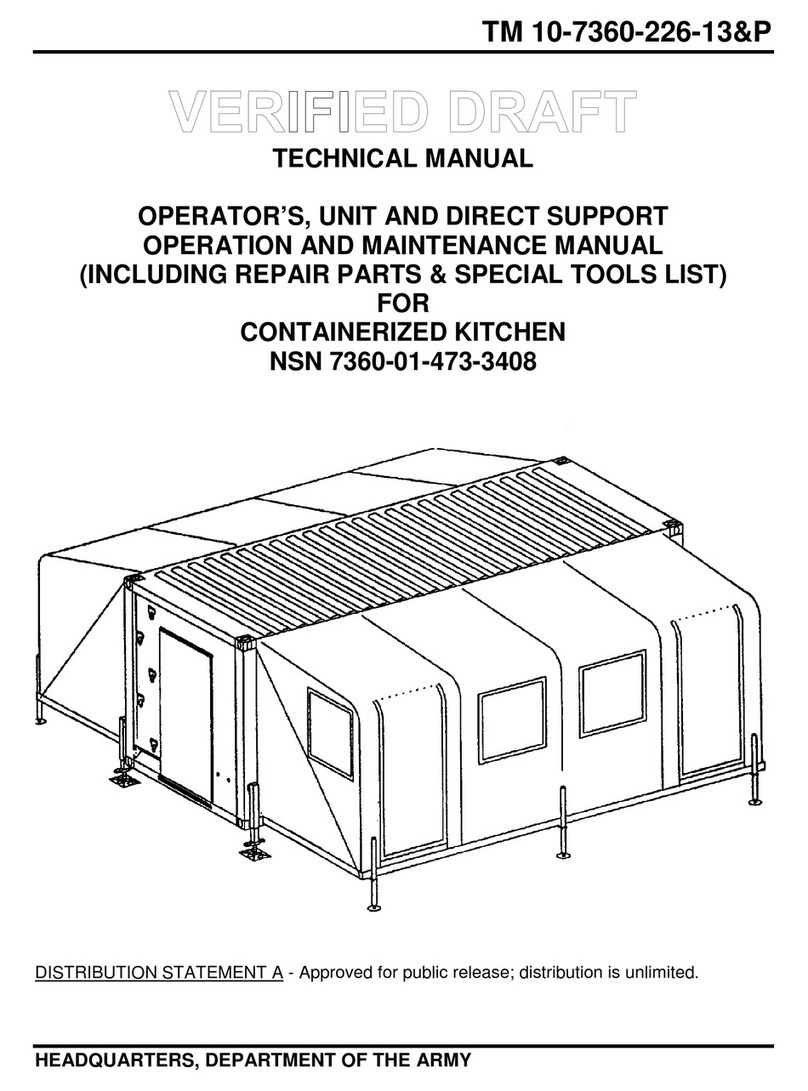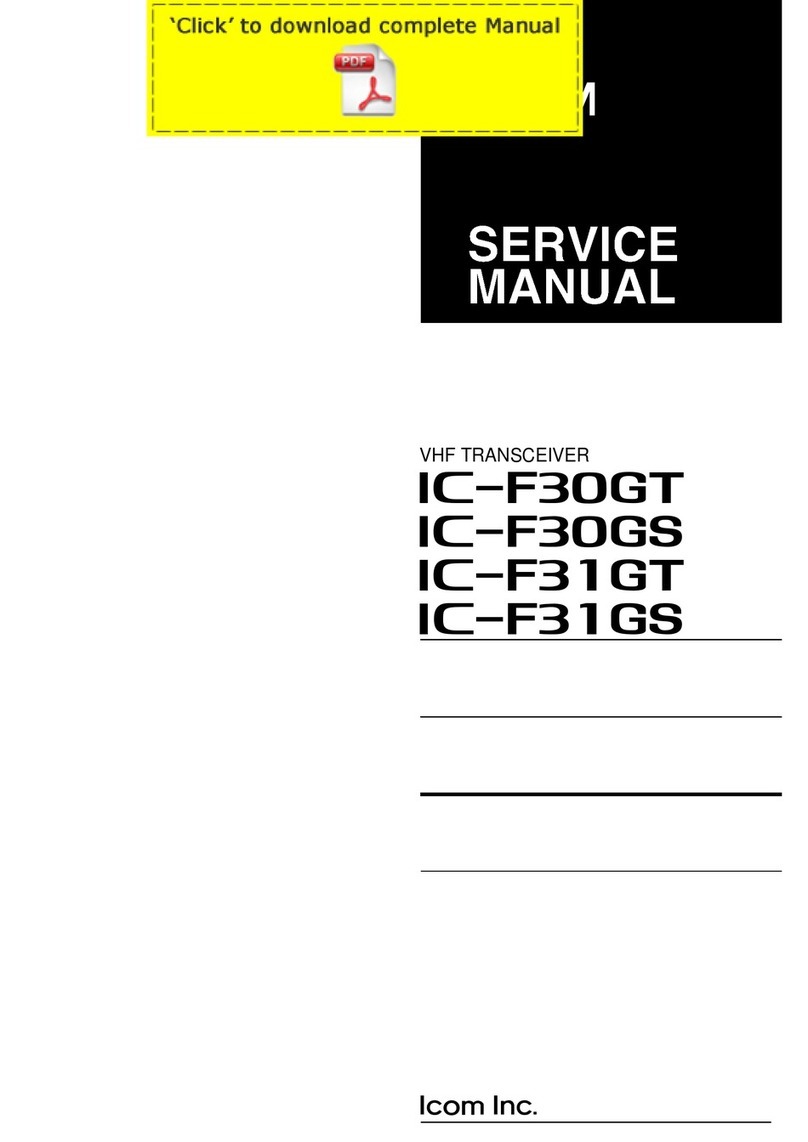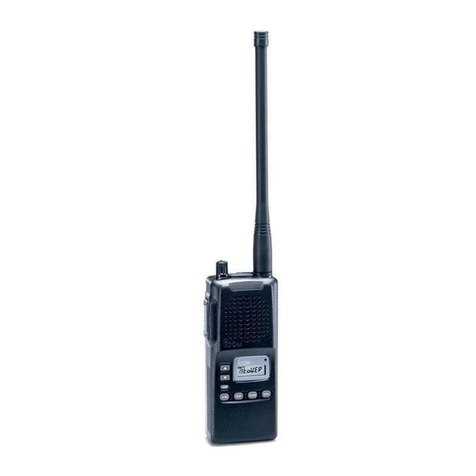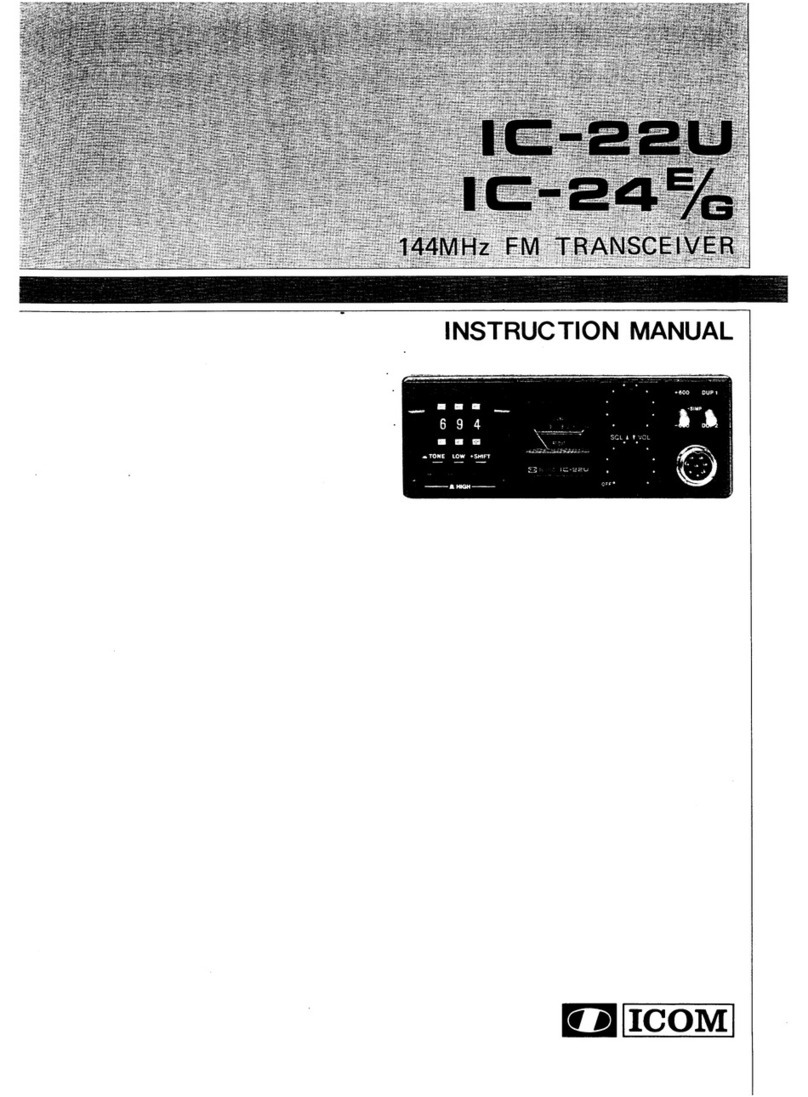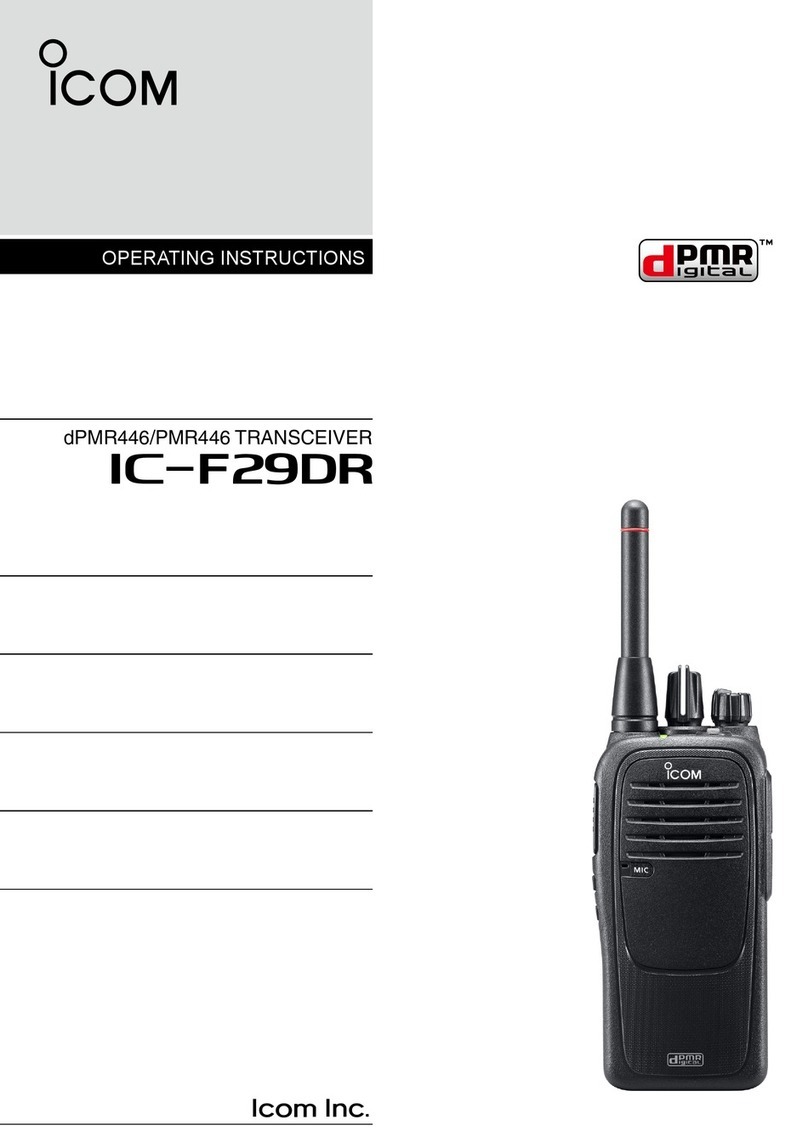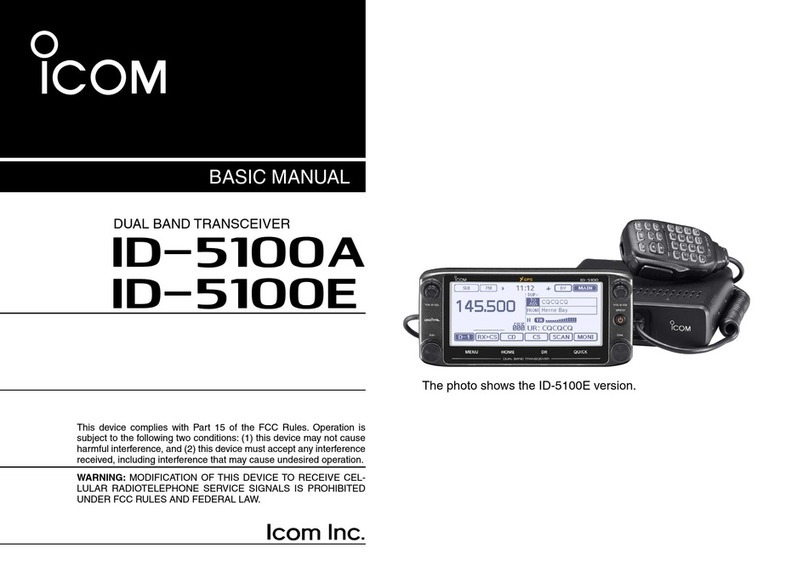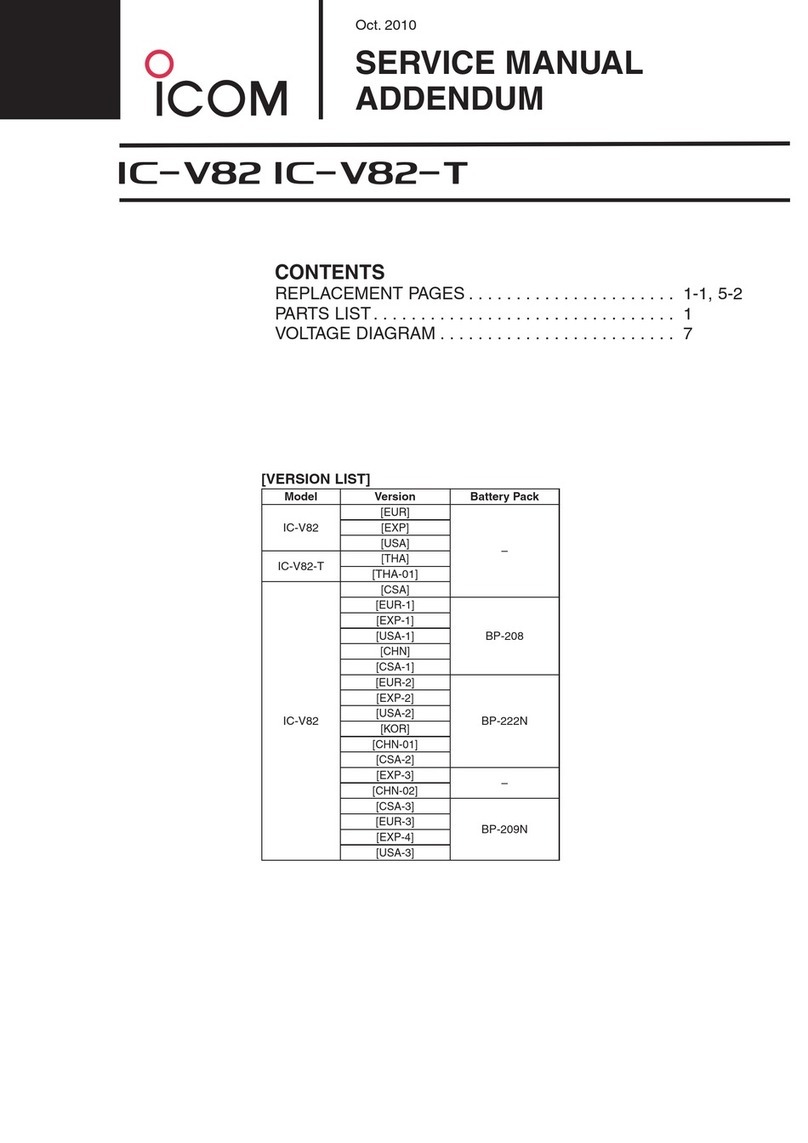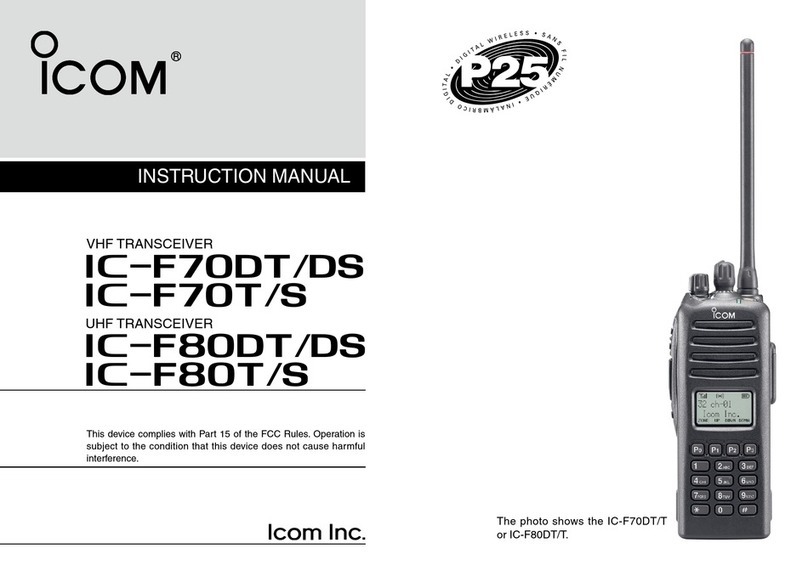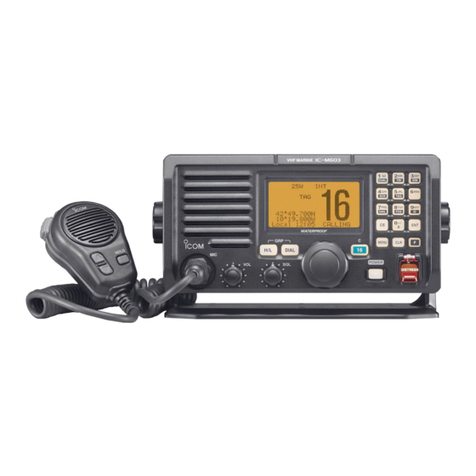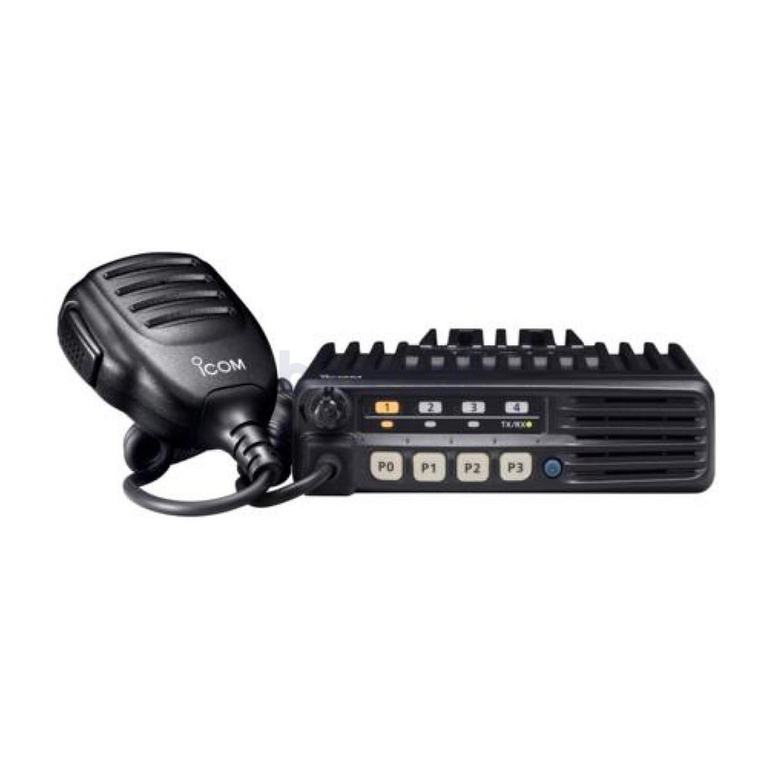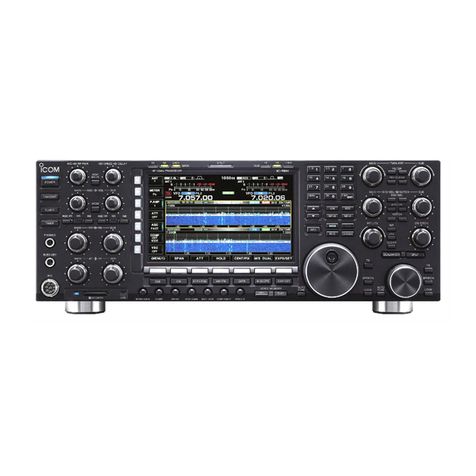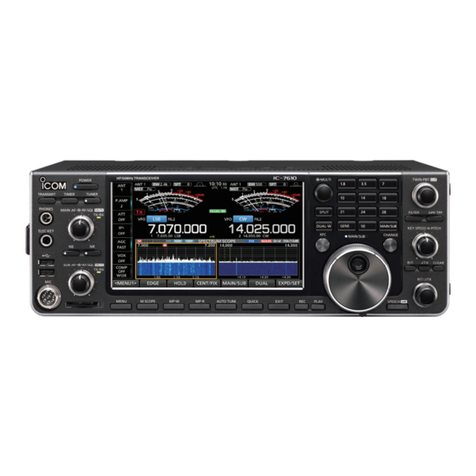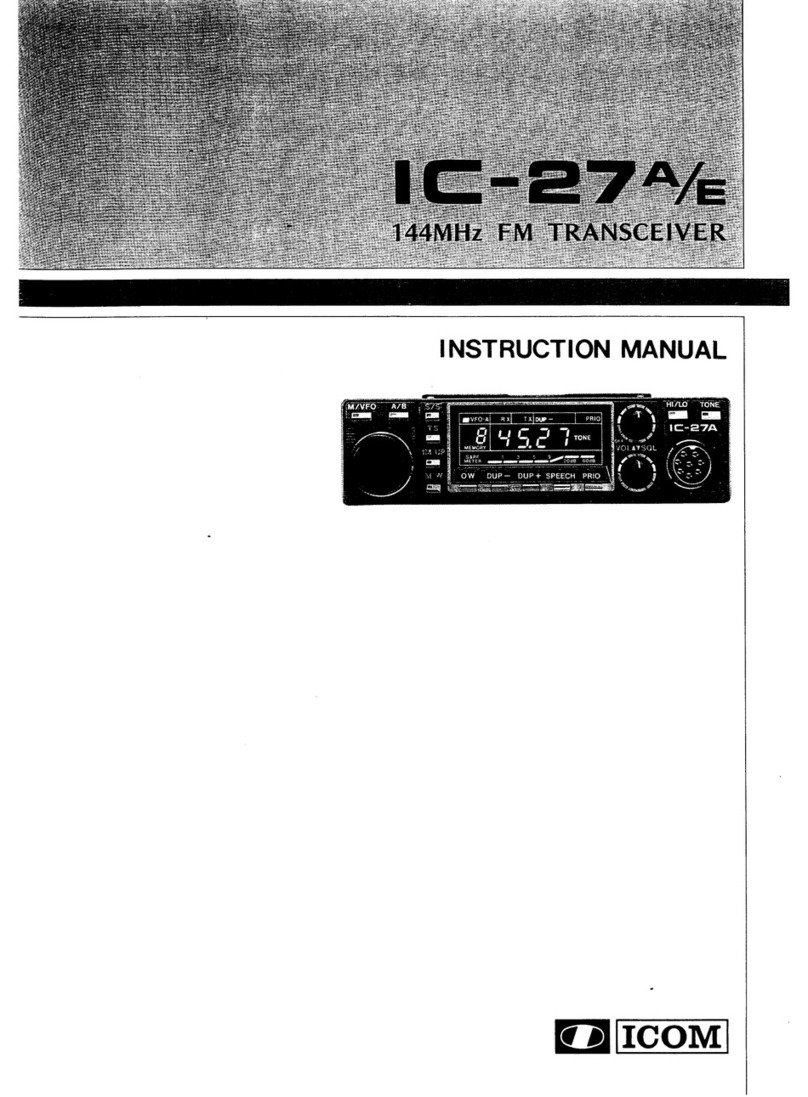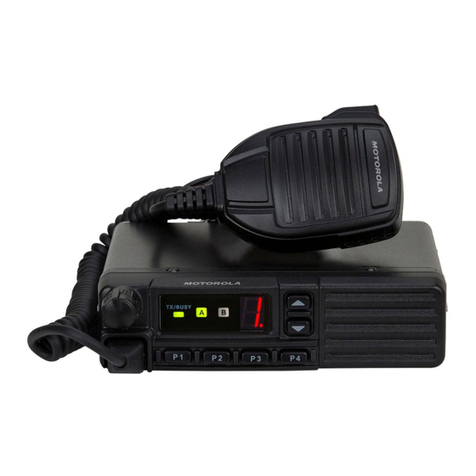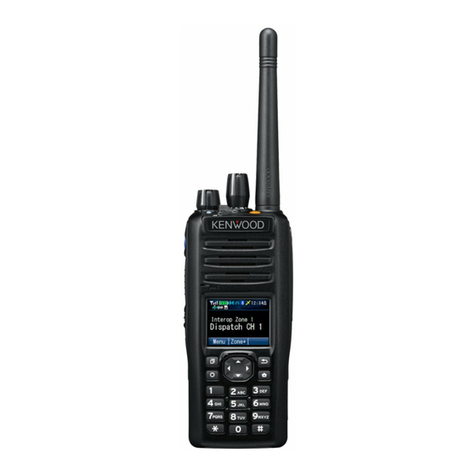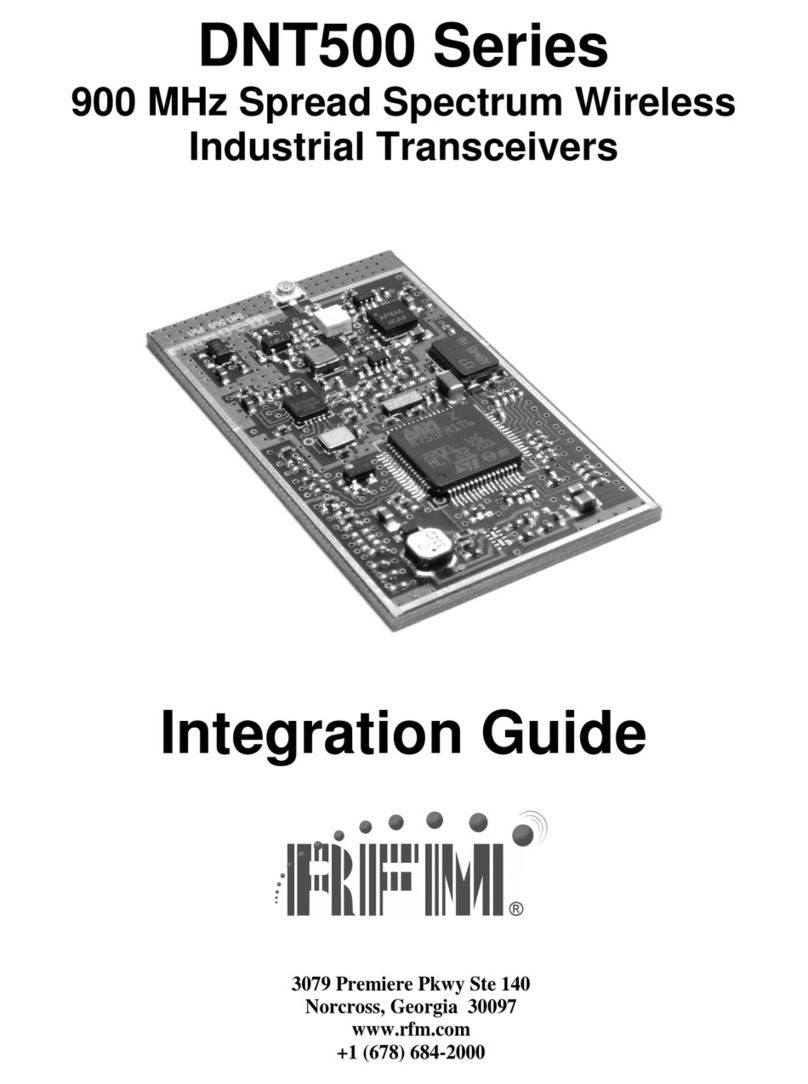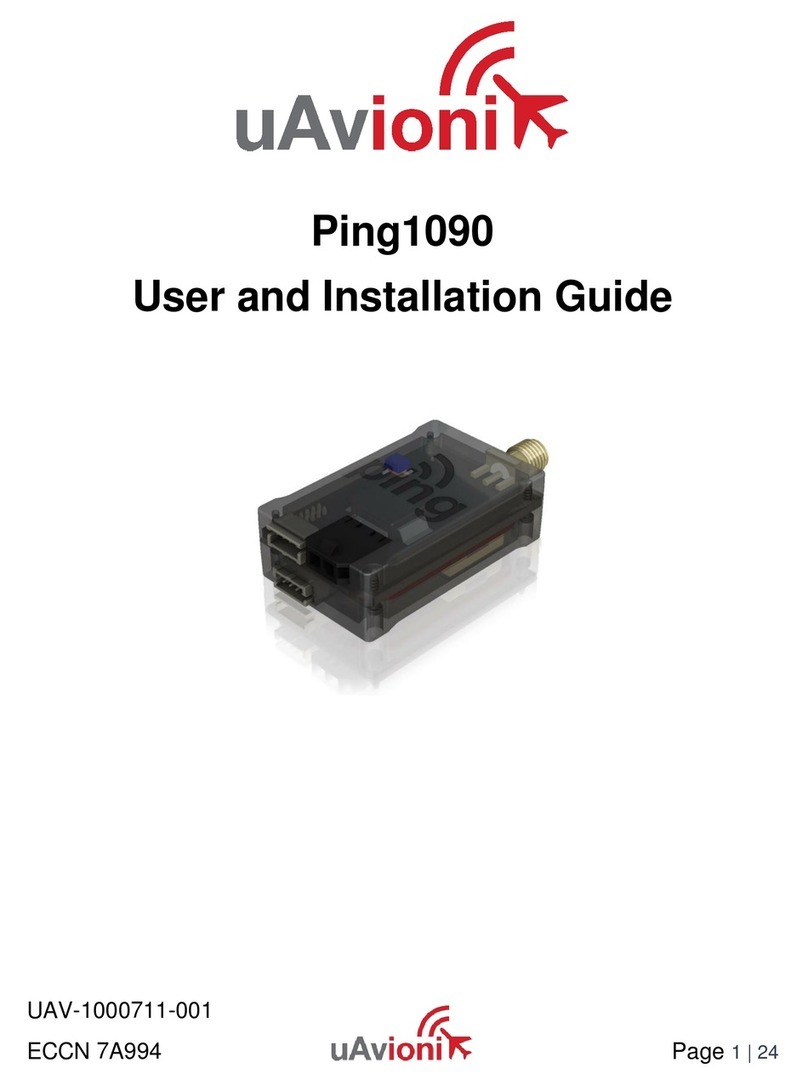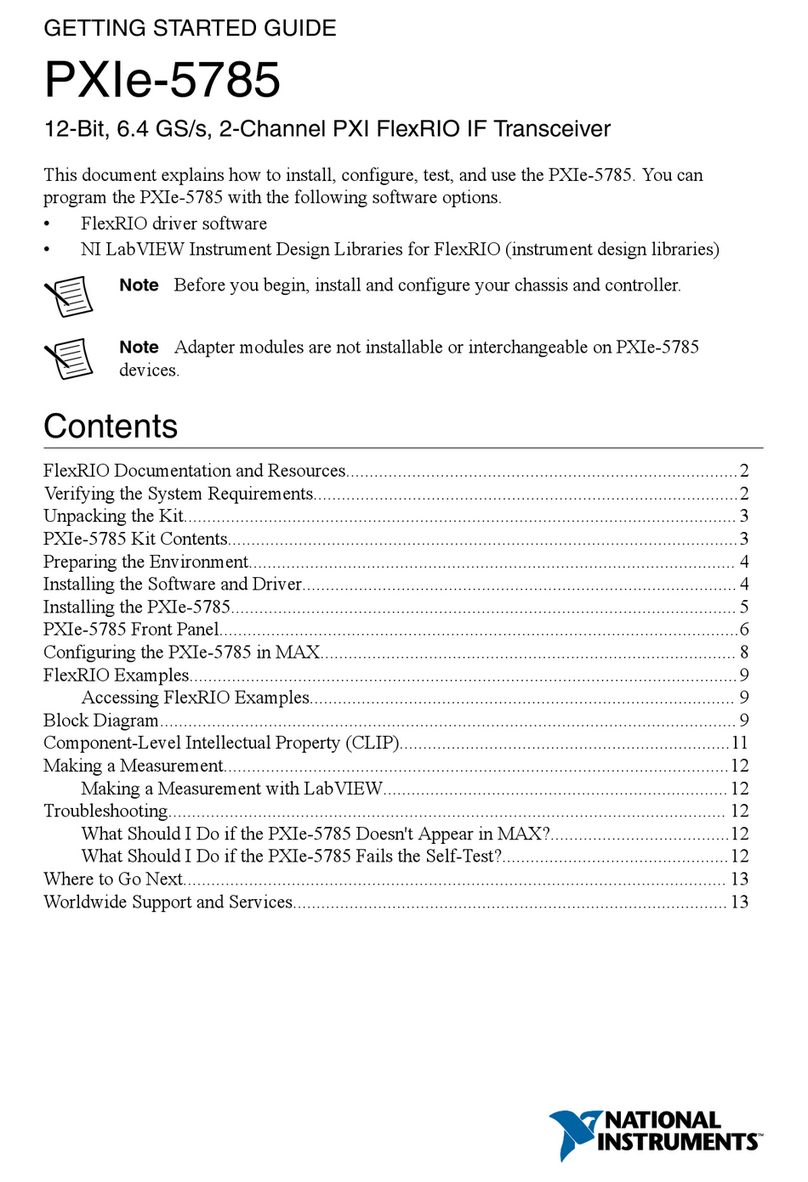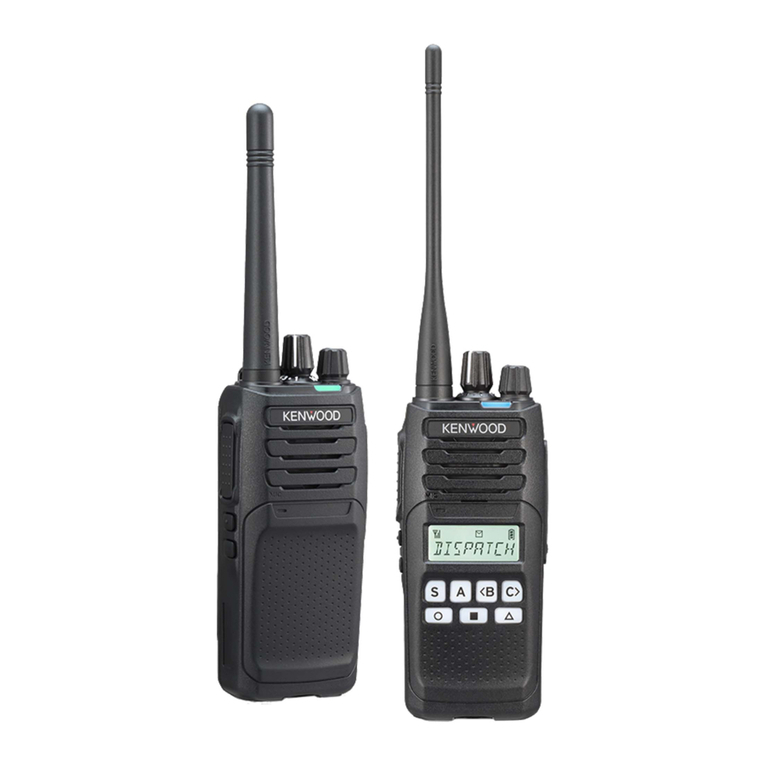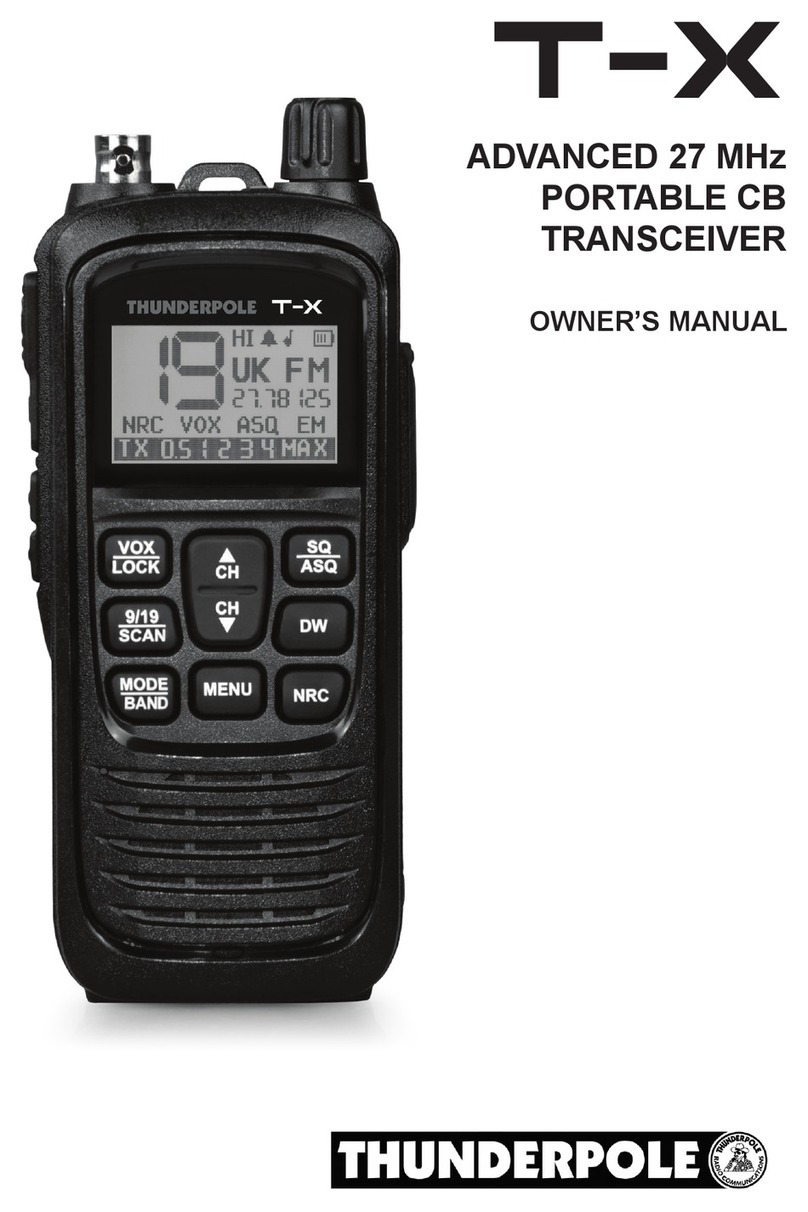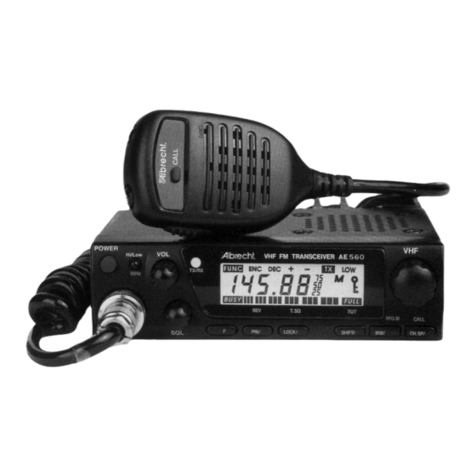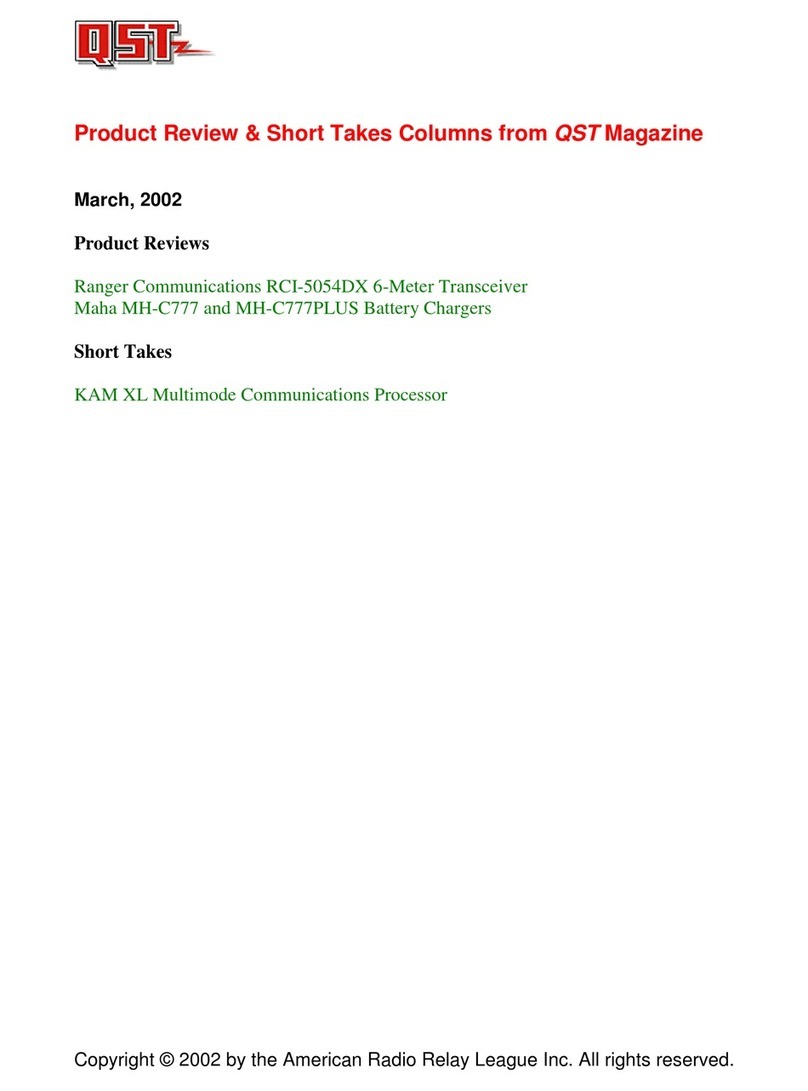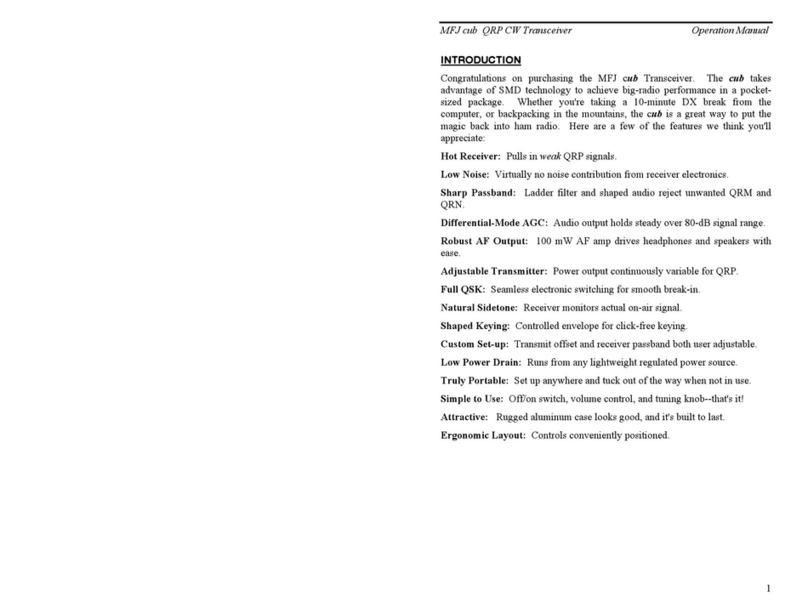Icom IC-G86 Setup guide

i
INTRODUCTION
Thank you for choosing this Icom product. This
product was designed and built with Icom’ s state of
the art technology and craftsmanship. With proper
care, this product should provide you with years of
trouble-free operation.
IMPORTANT
READ ALL INSTRUCTIONS carefully and completely
before using the transceiver.
SAVE THIS INSTRUCTION MANUAL — This
instruction manual contains advanced operating
instructions for the IC-G86. For basic operating
instructions, see the BASIC MANUAL.
FEATURES
zRugged construction (IP54*1and MIL-STD-810G)
LOnly when the battery pack or case, antenna, and
jack cover or optional HM-168LWP, HS-94LWP,
HS-95LWP are attached.
zPowerful 7 W of output power (Extra High power)
zExtend Battery Life function (With the BC-240)
Icom, Icom Inc. and the Icom logo are registered
trademarks of Icom Incorporated (Japan) in Japan,
the United States, the United Kingdom, Germany,
France, Spain, Russia, Australia, New Zealand, and/or
other countries.
All other products or brands are registered trademarks
or trademarks of their respective holders.
Icom is not responsible for the destruction, damage
to, or performance of any Icom or non-Icom
equipment, if the malfunction is because of:
• Force majeure, including, but not limited to, res,
earthquakes, storms, oods, lightning, other
natural disasters, disturbances, riots, war, or
radioactive contamination.
• The use of Icom transceivers with any equipment
that is not manufactured or approved by Icom.
EXPLICIT DEFINITIONS
WORD DEFINITION
RWARNING! Personal injury, re hazard or
electric shock may occur.
CAUTION Equipment damage may occur.
NOTE
If disregarded, inconvenience only.
No risk of personal injury, re or
electric shock.

1-1
Section 1ACCESSORIES
Supplied accessories..............................................................................1-2
Antenna ..................................................................................................1-2
Belt clip...................................................................................................1-2
Battery pack or case...............................................................................1-3
Jack cover ..............................................................................................1-3

1ACCESSORIES
1-2
Supplied accessories
Battery pack
Jack cover
(with screws)
Battery charger
Belt clip
Power adapter
Antenna
NOTE: Some accessories are not supplied, or the
shape is different, depending on the transceiver
version.
Antenna
Insert the antenna into the antenna connector and
rotate the antenna base to lock it in place.
CAUTION:
• DO NOT carry the transceiver by holding only the
antenna.
• DO NOT transmit without an antenna.
Belt clip
To attach the belt clip:
zSlide the belt clip in the direction of the arrow until
the belt clip locks in place, and makes a ‘click’
sound.
Belt clip
Battery pack/case
To detach the belt clip:
1. Remove the battery pack or case from the
transceiver, if it is attached.
2. Lift the tab up (1), and slide the belt clip in the
direction of the arrow (2).
-

1ACCESSORIES
1-3
Battery pack
To attach:
1. Insert the battery pack in the direction of the
arrow (1), then close.
2. Hook the latch until it makes a ‘click’ sound (2).
-
Battery pack
Latch
To detach:
RWARNING! The latch is tightly locked, so use
caution when releasing it. DO NOT use your
ngernail. Use the edge of a coin or screwdriver tip
to carefully release it.
zUnhook the latch (1), and then lift up the battery
pack in the direction of the arrow (2).
CAUTION: NEVER detach or attach the battery pack
when the transceiver is wet or soiled. This may result
in water or dust getting into the transceiver or the
battery pack, and may result in them being damaged.
NOTE: Keep battery terminals clean. It’s a good idea
to occasionally clean them.
Jack cover
Attach the jack cover when optional equipment is not
used.
To attach the jack cover
1. Attach the jack cover to the [SP MIC] jack (1).
2. Insert and tighten the screws (2).
To detach the jack cover
1. Remove the screws with a phillips screwdriver (1).
2. Detach the jack cover to connect optional
equipment (2).
-
-

2-1
Section
Battery chargers .....................................................................................2-2
DUsing the BC-191 to rapid charge the BP-264 ...............................2-2
DUsing the BC-192 to regular charge the BP-264 ............................2-2
DUsing the BC-240 to rapid charge the BP-298/BP-299 ..................2-3
2BATTERY CHARGE

2BATTERY CHARGE
2-2
The BC-191 provides rapid charging of only the
BP-264 Ni-MH battery pack. Never use it to charge
any other battery pack.
Charging time: Approximately 2 hours
Additionally needed item (purchase separately):
A power adapter (not supplied with some transceiver
versions) or the OPC-515L or CP-23L DC power cable.
LA power adapter may a different type, or no power
adapter is supplied, depending on the transceiver
version.
LThe optional OPC-515L (for a DC power source) or
CP-23L (for a 12 V cigarette lighter socket) can be
used instead of the power adapter.
NOTE: When the BC-191’s charging indicator lights
as below, it indicates the following states.
• Lights orange: While charging
• Lights green: When charging is completed.
The BC-192 provides regular charging of only the
BP-264 Ni-MH battery pack. Never use it to charge
any other battery pack.
Charging time:
At 12 V: Approximately 36 hours
At 13.8 V: Approximately 21 hours
At 16 V: Approximately 16 hours
LCharging time period differs, depending on the
input voltage.
Additionally needed item (purchase separately):
A power adapter (not supplied with some transceiver
versions) or the OPC-515L DC power cable.
LA power adapter may a different type, or no power
adapter is supplied, depending on the transceiver
version.
LThe optional OPC-515L (for a DC power source)
can be used instead of the power adapter.
NOTE: When the BC-192’s charging indicator lights
as below, it indicates the following state.
• Lights green: While charging.
LThe charge indicator will not go out even after a
battery pack is fully charged.
The optional OPC-515L
(for a DC power source)
or CP-23L (for a 12 V
cigarette lighter socket)
Power adapter
Battery pack + Transceiver
Turn OFF
Battery pack
The optional OPC-515L
(for a DC power source)
Power adapter
Battery pack + TransceiverBattery pack
Turn OFF
Battery chargers
DUsing the BC-191 to rapid charge the BP-264
DUsing the BC-192 to regular charge the BP-264
Screws
(Self tapping screw:
M3.5 × at least 30 mm)
LScrews are user
supplied.
LUsing screws are
recommended to
secure the charger.
Screws
(Self tapping screw:
M3.5 × at least 30 mm)
LScrews are user
supplied.
LUsing screws are
recommended to
secure the charger.

2BATTERY CHARGE
2-3
The BC-240 provides rapid charging of only the
BP-298/BC-299 Li-ion battery pack. Never use it to
charge any other battery pack.
Charging time*
With the BP-298: Approximately 3 hours
With the BP-299: Approximately 4.6 hours
* When the Extend Battery Life function is turned OFF.
See the BASIC MANUAL for details.
Additionally needed item (purchase separately):
A power adapter (not supplied with some transceiver
versions) or the OPC-515L or CP-23L DC power cable
.
LA power adapter may a different type, or no power
adapter is supplied, depending on the transceiver
version.
LThe optional OPC-515L (for a DC power source) or
CP-23L (for a 12 V cigarette lighter socket) can be
used instead of the power adapter.
CAUTION: When using the OPC-515L DC power
cable NEVER connect the OPC-515L to a power
source using reverse polarity. This will ruin the
battery charger. White line:
+
Black line:
–
NOTE: When the BC-240’s charging indicator lights
or blinks as below, it indicates the following states.
• Lights orange: While charging
• Lights green: When charging is completed.
• Blinks red:
When a charging error has occurred.
Reinstall the battery or the
transceiver.
The optional OPC-515L
(for a DC power source)
or CP-23L (for a 12 V
cigarette lighter socket)
Power adapter
Battery pack + TransceiverBattery pack
Turn OFF
Screws
(Self tapping screw:
M3.5 × at least 30 mm)
LScrews are user
supplied.
LUsing screws are
recommended to
secure the charger.
Battery chargers
DUsing the BC-240 to rapid charge the BP-298/BP-299

3-1
Section
Adjusting the audio level.........................................................................3-2
Selecting passband width.......................................................................3-2
[VOL] function assignment .....................................................................3-2
3ADVANCED OPERATION

3ADVANCED OPERATION
3-2
Adjusting the audio level
zRotate [VOL]* to adjust the audio level.
• The display shows the audio level while adjusting.
LIf the squelch is closed, hold down [MONI] while
adjusting the audio level.
[DIAL]
[VOL]
* Use [VOL] or [Y]/[Z], depending on the setting of the “Dial
assignment” in the Initial Set mode. (p. 8-6)
Selecting passband width
Set both the transmission and reception passband
width to wide or narrow.
1. Push [FUNC], and then push [SET] to enter the
Set mode.
2. Push [Y] or [Z] to select the passband width item
(W/n).
3. Rotate [VOL] to select the passband width.
• “W”: Wide (FM mode)
• “n”: Narrow (FM-N mode)
4. Push [# ENT] to exit the Set mode.
The “Passband width” item in the Set mode
(FM mode is selected) (FM-N mode is selected)
[VOL] function assignment
[VOL] can be used as a channel selector instead of
[Y] and [Z], to suit your preference. However, when
[VOL] functions as a channel selector, [Y] and [Z]
function as volume controls.
1.
Hold down [ ] for 1 second to turn OFF the power.
2.
While holding down [Y] and [Z], turn ON the power
to enter the Initial Set mode.
3. Push [Y] or [Z] to select the dial assignment item
(tOP).
4. Rotate [VOL] to select an option.
5. Push [# ENT] to exit the Initial Set mode.
[VOL] and [Y]/[Z] function as described below,
depending on the option.
Option [VOL] [Y]/[Z]
tOP.VO Volume control Channel selector
tOP.di Channel selector Volume controls
The “Dial assignment” item in the Set mode
[VOL] functions as the volume control.
[VOL] functions as the channel selector.

4-1
Section
About repeater........................................................................................4-2
Talk Around function ...............................................................................4-2
DTCS encoder (Only TX) .......................................................................4-3
Lockout function .....................................................................................4-3
Subaudible tones....................................................................................4-3
REPEATER OPERATION
4

4REPEATER OPERATION
4-2
To communicate with another station in an area where
radio waves cannot directly received, you can use a
repeater as a relay. This is called duplex operation.
The frequencies are pre-programmed into an
operating channel for duplex operation. Ask your
dealer for details.
1. Push [Y] or [Z] to select a channel that has been
programmed for repeater use.
LThe frequencies are pre-programmed into
channels using the CS-G86 programming
software. Ask your dealer for details.
2. Push [FUNC], and then push [TONE] several
times to turn ON the subaudible tone encoder,
depending on the repeater requirements.
• “ ” is displayed.
LThe subaudible tone frequency can be set in
the Set mode.
3. Hold down [PTT] to transmit.
4. Release [PTT] to receive.
5. Hold down [MONI] to check whether you can
directly receive the signal from the other station.
LWhen the other station’s signal can be directly
received, move to a non-repeater frequency to
use simplex. (duplex OFF)
About repeater
Turning ON the subaudible tone encoder
[DIAL]
Displayed
Repeater
Station A Station B
144.700 MHz144.700 MHz
145.300 MHz145.300 MHz
Uplink
(transmit frequency)
Downlink
(receive frequency)
Talk Around function
The Talk Around function equalizes the transmit
frequency to the receive frequency for transceiver-
to-transceiver communication. Duplex operation
temporarily changes to simplex operation.
This function is convenient at the following situations
when:
- The repeater is broken down and is not usable.
- You cannot access the repeater because of distance,
low power or location.
- You can easily contact the other transceiver without
using the repeater.
1. Push [Y] or [Z] to select a channel that has been
programmed for repeater use.
2. Push [FUNC] and then push [T/A] to turn ON the
Talk Around function.
• “ ” is displayed.
3. Push [PTT] to transmit.
4. Release [PTT] to receive on the same frequency.
• The transmit frequency is same as the receive
frequency.
Turning ON the Talk Around function
[DIAL]
Displayed

4REPEATER OPERATION
4-3
The DTCS encoder superimposes the selected DTCS
code over your transmitted signal.
1. Push [FUNC], and then push [SET] to enter the
Set mode.
2. Set the DTCS code and polarity, in the same way
you set the DTCS squelch. (p. 6-2)
LYou can set the DTCS transmit and receive
polarity, but the DTCS encoder affects only
transmit.
3. Push [# ENT] to exit the Set mode.
4. Push [FUNC], and then push [TONE] several
times, until both “
D
” and “ ” are displayed.
• The DTCS encoder is activated.
The “Lockout” item in the Initial Set mode
(The Repeater Lockout function is OFF.)
(The Repeater Lockout function is ON.)
(The Busy Lockout function is ON. )
Lockout function
Push , and then push several times
to turn ON the DTCS encoder.
DTCS encoder (Only TX)
DTCS encoder (Only TX)
This function helps prevent interference to other
stations by inhibiting transmitting when a signal is
received. The transceiver has two inhibiting modes,
repeater and busy.
1. Hold down [ ] for 1 second to turn OFF the
transceiver.
2. While holding down [Y] and [Z], turn ON the
transceiver to enter the Initial Set mode.
3. Push [Y] or [Z] to select the lockout item (RLO).
4. Rotate [VOL] to select the Lockout function option
of “RP,” “bU” or “OF.”
• “RLO.OF”: The Lockout function is OFF.
• “RLO.RP”: The transmit is inhibited when a
signal with an unmatched subaudible
tone is received.
• “RLO.bU”: Transmit is inhibited when a signal is
received.
5. Push [# ENT] to exit the Initial Set mode.

4REPEATER OPERATION
4-4
Subaudible tones
Some repeaters require subaudible tones to access.
Subaudible tones are superimposed over your normal
signal, and must be set in advance.
1. Push [FUNC], and then push [SET] to enter the
Set mode.
2. Push [Y] or [Z] to select the repeater tone item.(rt)
3. Rotate [VOL] to select the desired subaudible
tone frequency.
4. Push [#ENT] to exit the Set mode.
DTone information
Some repeaters require a different tone system to be
accessed.
DTMF Tones
While holding down [PTT], push the desired DTMF
keys, [0] to [9], [MONI](A), [Y](B), [Z](C), [ ](D),
[*](E), and [#ENT](F) to transmit their assigned DTMF
codes.
DTCS codes
Push [FUNC](*), and then [TONE](1) one or more times
to activate the DTCS encoder, and then push [PTT].
• “
D
” and “ ” is displayed.
• The specied DTCS code is superimposed over
your transmitted signal.
LSee the CTCSS tone or DTCS code. (p. 6-2)
NOTE: If you don’t know the subaudible tone or
DTCS code used for a repeater, the tone scan is
convenient for detecting it.
Push
[FUNC](*), and then [T.SCAN](3) to start a tone
scan.
• When the required tone frequency or DTCS code is
detected, the scan pauses, and it is temporarily set.
LSee the Tone scan function. (p. 6-5)
Available subaudible tones
67.0 79.7 94.8 110.9 131.8 156.7 171.3 186.2 203.5 229.1
69.3 82.5 97.4 114.8 136.5 159.8 173.8 189.9 206.5 233.6
71.9 85.4 100.0 118.8 141.3 162.2 177.3 192.8 210.7 241.8
74.4 88.5 103.5 123.0 146.2 165.5 179.9 196.6 218.1 250.3
77.0 91.5 107.2 127.3 151.4 167.9 183.5 199.5 225.7 254.1
Setting the subaudible tone
[DIAL]
88.5 Hz repeater tone

5-1
Section
Scan types..............................................................................................5-2
DMemory scan ..................................................................................5-2
DPriority watch ..................................................................................5-2
Setting Skip channels.............................................................................5-3
Scan Resume setting .............................................................................5-3
SCAN OPERATION
5

5SCAN OPERATION
5-2
A scan automatically searches for signals, and makes it easier to locate new stations for contact or listening purposes.
Scan types
DMemory scan
Repeatedly scans memory channels, except those set
as skip channels, described in the next scan topic.
1. Push [FUNC], and then push [SCAN] to start the
scan.
• “X” blinks.
LTo change the scan direction, push [Y] or [Z].
2. To cancel the scan, push any key except [ ], [Y]/
[Z], [MONI] or [FUNC].
DPriority watch
The priority watch checks for signals on the selected
channel (Priority channel) every 5 seconds. A priority
channel must be set rst.
Setting the Priority channel
1. Push [Y] or [Z] to select the channel.
2. Push [FUNC], and then hold down [PRIO] for 1
second to set the selected channel as a Priority
channel.
• 2 beeps sound and “PRIO” is displayed for 1
second.
Starting Priority Watch
3. Push [FUNC], and then [PRIO] to start the Watch.
• The decimal point “.” on the alphanumeric
display blinks.
• When a signal is received on the channel, the
Watch pauses, and resumes depending on the
selected scan resume option.
4. To cancel the watch, push any key except [ ], [Y]/
[Z], [MONI], [FUNC], or [PTT].
SKIP SKIP
Mch 1
Mch 200
Mch 2 Mch 3 Mch 4 Mch 5
Mch 10
Mch 199
Mch 9 Mch 8 Mch 7
Mch 6

5SCAN OPERATION
5-3
Example: Setting memory channel 11 as the
Skip channel.
Push to select channel 11.or
Push , and push .
Displayed
The “Scan pause timer” item in the Set mode
(Pause scan is selected.)
(Timer scan (15 seconds) is selected.)
The Memory Skip function speeds up scanning by
not scanning those memory channels set as Skip
channels. Set the Skip channels as follows.
1. Push [Y] or [Z] to select the memory channel to
be skipped.
2. Push [FUNC], and then push [SKIP] to set the
channel as a Skip channel.
• “SKIP” is displayed.
Various pause and timer options can be selected with
the Scan Resume function. The selected resume
option is also used for Priority Watch.
1. Push [FUNC], and then push [SET] to enter the
Set mode.
2. Push [Y] or [Z] to select the scan pause timer
item (SCt, or SCP).
3. Rotate [VOL] to select the desired scan resume
option.
• “SCt. 5/10/15”: Timer scan
The scan pauses for 5 to 15
seconds, when a signal is
received.
• “SCP. 2”: Pause scan
The scan pauses, then resumes
2 seconds after the signal
disappears.
4. Push [# ENT] to exit the Set mode.
Setting Skip channels
Scan Resume setting

6-1
Section
Tone/DTCS squelch................................................................................6-2
DTone squelch and DTCS squelch ...................................................6-2
DSetting CTCSS tone or DTCS code................................................6-2
DSetting DTCS polarity .....................................................................6-2
DOperation ........................................................................................6-3
Pocket Beep function..............................................................................6-4
Tone scan ...............................................................................................6-5
TONE SQUELCH AND POCKET BEEP
6

6TONE SQUELCH AND POCKET BEEP
6-2
DTone squelch and DTCS squelch
The tone squelch or DTCS squelch opens when a
signal with the same pre-programmed CTCSS tone or
DTCS code is received.
DSetting CTCSS tone or DTCS code
1. Push [FUNC], and then push [SET] to enter the
Set mode.
2. Push [Y] or [Z] to select the Tone squelch
frequency item (Ct) or the DTCS code item (dt).
• “ ” blinks when selecting the Tone squelch
frequency item, and “
D
” blinks when selecting
the DTCS code item.
3. Rotate [VOL] to set the desired CTCSS tone, or
DTCS code.
4. Push [# ENT] to exit the Set mode.
DSetting DTCS polarity
For DTCS operation, the polarity setting is also
congurable, as well as the code setting. If the polarity
is different, the DTCS squelch never opens, even
when receiving a signal that includes a matching
DTCS code.
1. Push [FUNC], and then push [SET] to enter the
Set mode.
2. Push [Y] or [Z] to select the DTCS polarity item
(dtP).
3. Rotate [VOL] to select the desired polarity.
• “dtP.nn”: Normal
• “dtP.nR”: Normal for TX, reverse for RX
• “dtP.Rn”: Reverse for TX, normal for RX
• “dtP.RR”: Reverse
4. Push [# ENT] to exit the Set mode.
The “Tone squelch frequency” item in the Set mode
The “DTCS code” item in the Set mode
CTCSS tone setting (88.5 Hz is selected.)
DTCS code setting (023 is selected.)
The “DTCS polarity” item in the Set mode
TX and RX: Normal polarity TX: Normal, RX: Reverse
TX: Reverse, RX: Normal TX and RX: Reverse polarity
Tone/DTCS squelch
Recommended CTCSS tones
67.0 79.7 94.8 110.9 131.8 156.7 186.2 225.7
69.3 82.5 97.4 114.8 136.5 162.2 192.8 233.6
71.9 85.4 100.0 118.8 141.3 167.9 203.5 241.8
74.4 88.5 103.5 123.0 146.2 173.8 210.7 250.3
77.0 91.5 107.2 127.3 151.4 179.9 218.1
Recommended DTCS codes
023 051 114 143 174 251 315 371 445 532 631 723
025 054 115 152 205 261 331 411 464 546 632 731
026 065 116 155 223 263 343 412 465 565 654 732
031 071 125 156 226 265 346 413 466 606 662 734
032 072 131 162 243 271 351 423 503 612 664 743
043 073 132 165 244 306 364 431 506 624 703 754
047 074 134 172 245 311 365 432 516 627 712

6TONE SQUELCH AND POCKET BEEP
6-3
DOperation
1. Select the operating channel.
2. Push [FUNC], and then push [SET] to enter the
Set mode.
3. Set the tone frequency, or DTCS code and DTCS
polarity.
4. Push [# ENT] to exit the Set mode.
5. Push [FUNC], and then push [TONE] several
times, until the icon of desired Tone function is
displayed.
• “ ”: Repeater tone encoder
• “ ” and “ ”: CTCSS Pocket Beep function
• “ ”: CTCSS squelch function
• “
D
” and “ ”: DTCS encoder (Only TX)
• “
D
” and “ ”: DTCS Pocket Beep function
• “
D
”: DTCS squelch function
LWhen the CTCSS or DTCS squelch function is ON,
the tone encoder is activated while transmitting.
6. Operate the transceiver in a normal way; push
[PTT] to transmit, release [PTT] to receive.
7. When a signal with matching tones or codes is
received, the squelch opens and audio is heard.
LTo manually open the squelch, push [MONI].
LIf the signal includes an unmatching tones,
the squelch does not open. However, the icon
shows the strength of the received signal.
8. To cancel the tone or DTCS squelch, push
[FUNC], and then push [TONE] several times,
until the tone icon disappears.
CTCSS burst:
While using the tone squelch, noise may be heard
just when the received signal disappears.
To eliminate the noise, the transceiver has the
CTCSS Burst function. See page 8-7 for details.
Repeater tone
encoder
CTCSS squelch with
pocket beep
CTCSS squelch
DTCS encoder (Only TX)
Function OFF
DTCS squelch
DTCS squelch with
pocket beep
Push , and then push to sequentially select
the tone function.
Tone/DTCS squelch
Table of contents
Other Icom Transceiver manuals

